LSC UoS BA Business: Organisational Analysis of Thomas Cook
VerifiedAdded on 2023/01/10
|12
|3682
|83
Report
AI Summary
This report provides a comprehensive analysis of Thomas Cook, a UK-based global travel company, examining various aspects of its organizational theory and practice. It begins by exploring the management styles adopted by the CEO, including democratic and laissez-faire approaches, along with the principles and functions of management employed. The report then delves into the organizational structure, analyzing the steps taken to enhance performance, such as employee engagement and reduction in organizational levels, as well as the company's culture based on Edgar Schein’s Model. Furthermore, the report describes the CEO's leadership styles, including transformational and participative approaches, to improve organizational effectiveness. It also analyzes the effects of power, influence, and conflict within the firm, considering sources like coercion, expertise, and rewards. Finally, the report discusses the types of motivation used at Thomas Cook and concludes with recommendations for improvement.
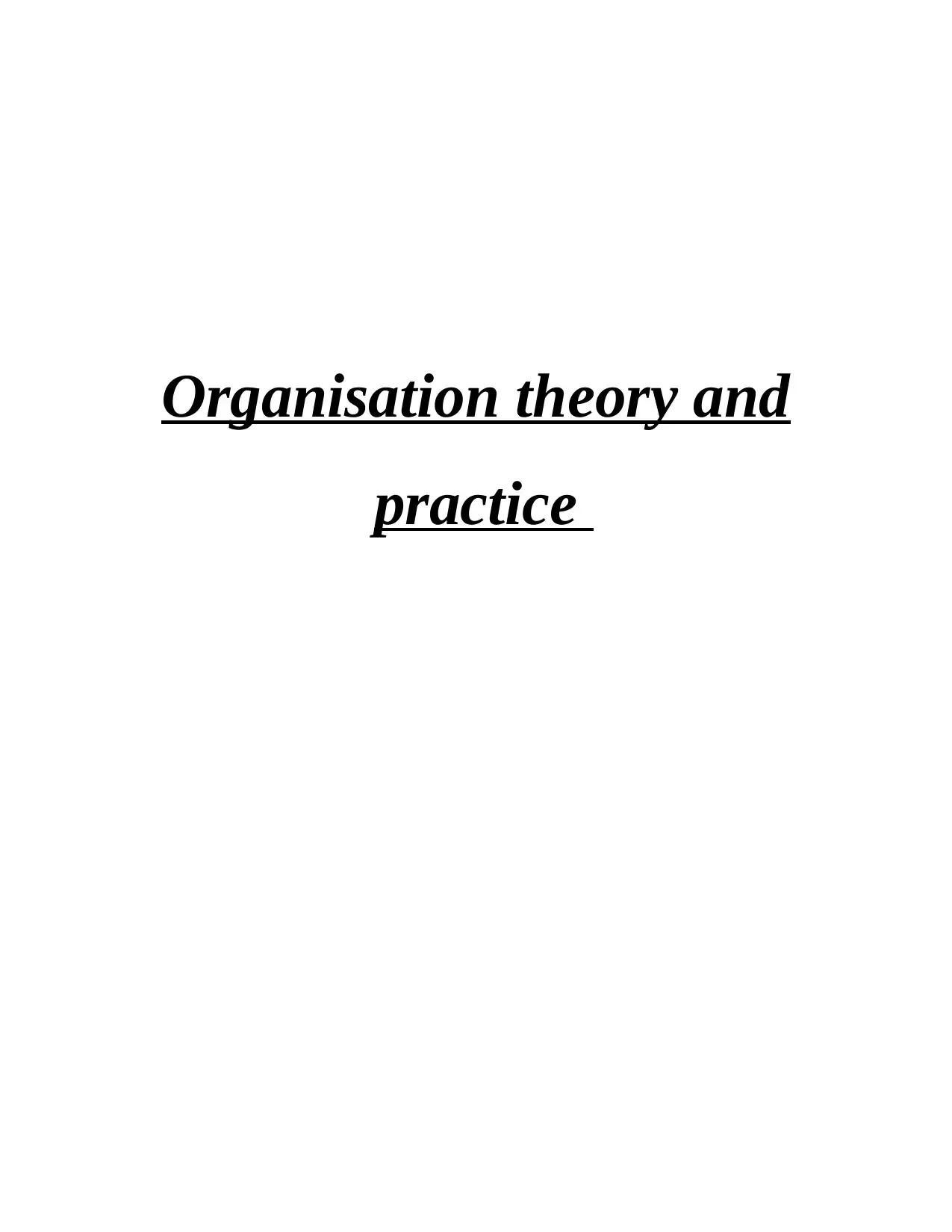
Organisation theory and
practice
practice
Paraphrase This Document
Need a fresh take? Get an instant paraphrase of this document with our AI Paraphraser
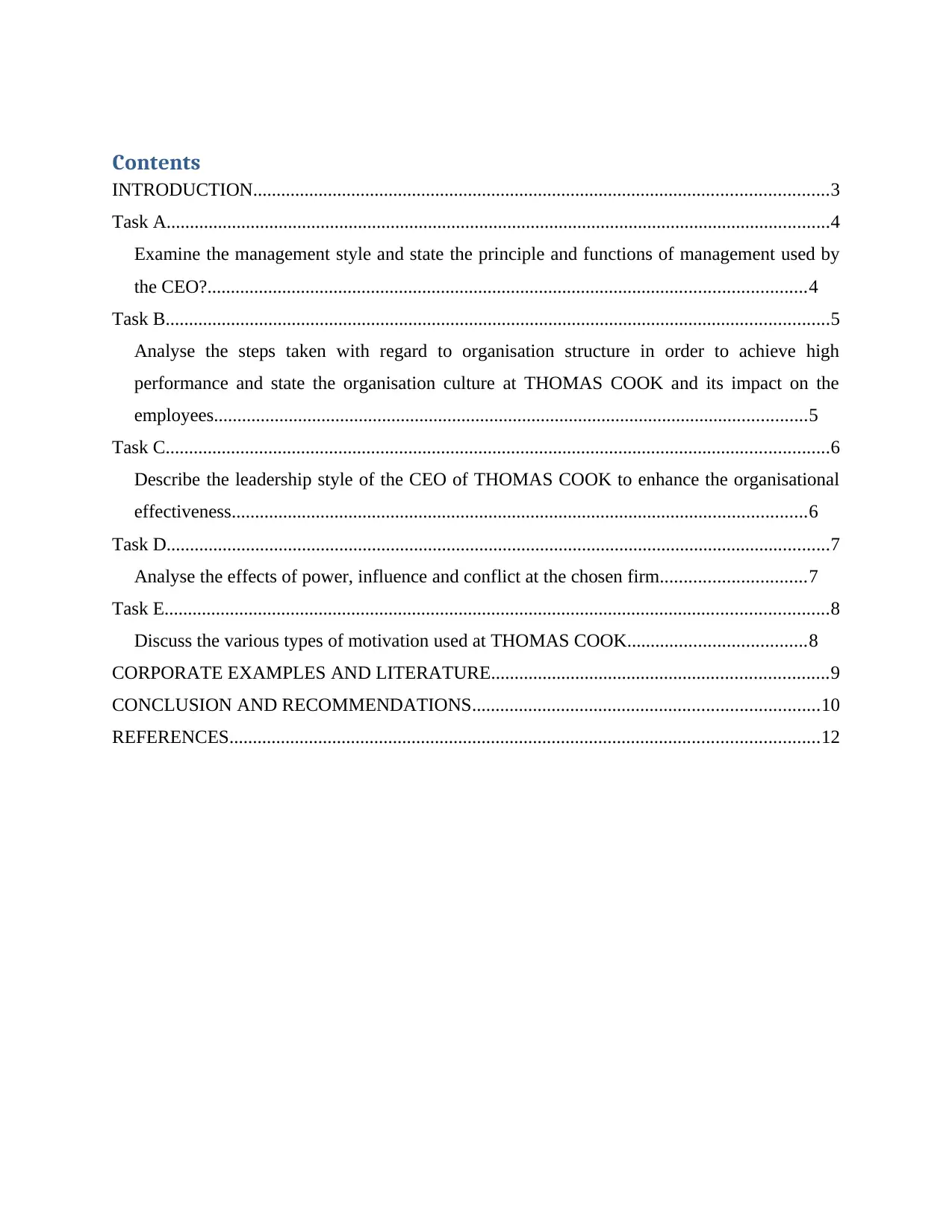
Contents
INTRODUCTION...........................................................................................................................3
Task A..............................................................................................................................................4
Examine the management style and state the principle and functions of management used by
the CEO?................................................................................................................................4
Task B..............................................................................................................................................5
Analyse the steps taken with regard to organisation structure in order to achieve high
performance and state the organisation culture at THOMAS COOK and its impact on the
employees...............................................................................................................................5
Task C..............................................................................................................................................6
Describe the leadership style of the CEO of THOMAS COOK to enhance the organisational
effectiveness...........................................................................................................................6
Task D..............................................................................................................................................7
Analyse the effects of power, influence and conflict at the chosen firm...............................7
Task E..............................................................................................................................................8
Discuss the various types of motivation used at THOMAS COOK......................................8
CORPORATE EXAMPLES AND LITERATURE........................................................................9
CONCLUSION AND RECOMMENDATIONS..........................................................................10
REFERENCES..............................................................................................................................12
INTRODUCTION...........................................................................................................................3
Task A..............................................................................................................................................4
Examine the management style and state the principle and functions of management used by
the CEO?................................................................................................................................4
Task B..............................................................................................................................................5
Analyse the steps taken with regard to organisation structure in order to achieve high
performance and state the organisation culture at THOMAS COOK and its impact on the
employees...............................................................................................................................5
Task C..............................................................................................................................................6
Describe the leadership style of the CEO of THOMAS COOK to enhance the organisational
effectiveness...........................................................................................................................6
Task D..............................................................................................................................................7
Analyse the effects of power, influence and conflict at the chosen firm...............................7
Task E..............................................................................................................................................8
Discuss the various types of motivation used at THOMAS COOK......................................8
CORPORATE EXAMPLES AND LITERATURE........................................................................9
CONCLUSION AND RECOMMENDATIONS..........................................................................10
REFERENCES..............................................................................................................................12
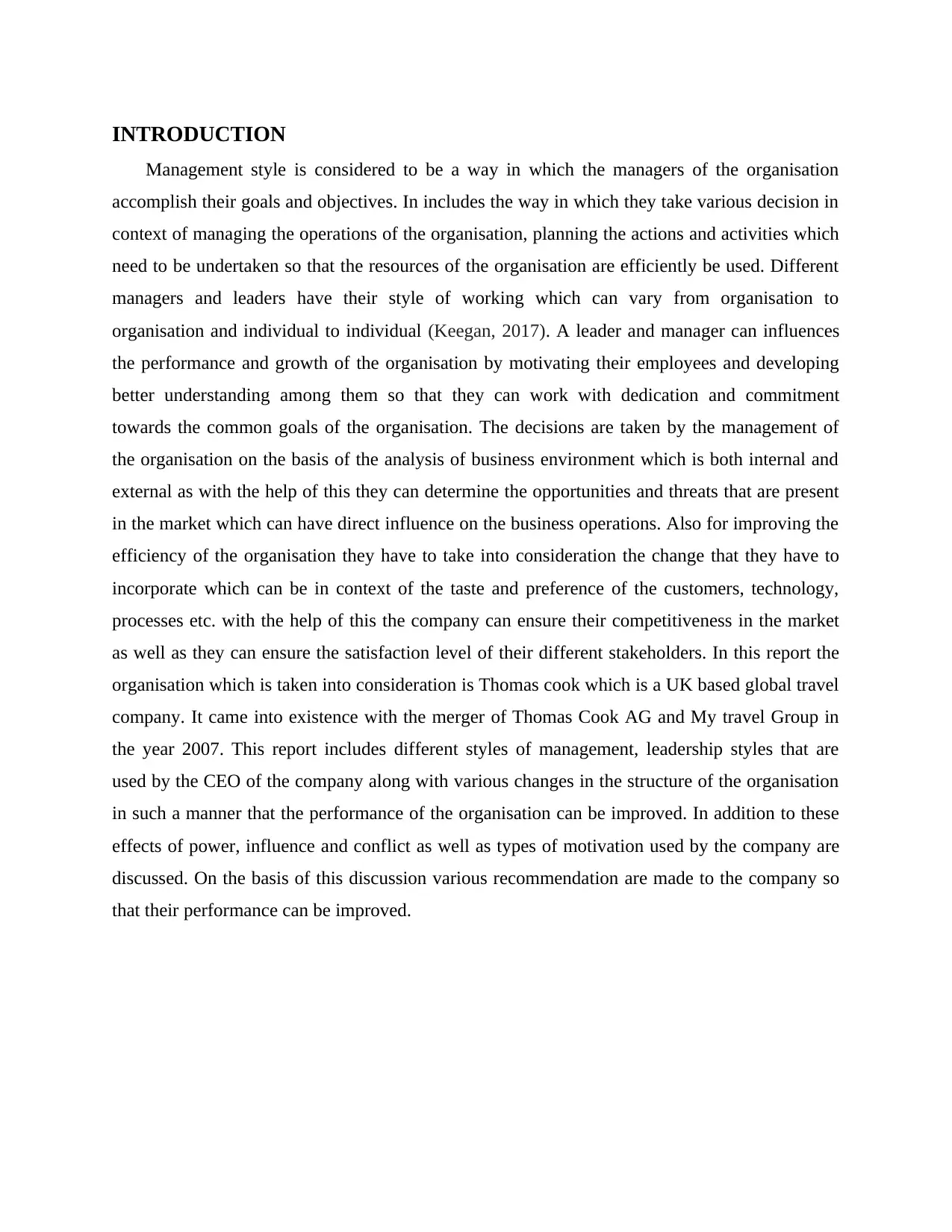
INTRODUCTION
Management style is considered to be a way in which the managers of the organisation
accomplish their goals and objectives. In includes the way in which they take various decision in
context of managing the operations of the organisation, planning the actions and activities which
need to be undertaken so that the resources of the organisation are efficiently be used. Different
managers and leaders have their style of working which can vary from organisation to
organisation and individual to individual (Keegan, 2017). A leader and manager can influences
the performance and growth of the organisation by motivating their employees and developing
better understanding among them so that they can work with dedication and commitment
towards the common goals of the organisation. The decisions are taken by the management of
the organisation on the basis of the analysis of business environment which is both internal and
external as with the help of this they can determine the opportunities and threats that are present
in the market which can have direct influence on the business operations. Also for improving the
efficiency of the organisation they have to take into consideration the change that they have to
incorporate which can be in context of the taste and preference of the customers, technology,
processes etc. with the help of this the company can ensure their competitiveness in the market
as well as they can ensure the satisfaction level of their different stakeholders. In this report the
organisation which is taken into consideration is Thomas cook which is a UK based global travel
company. It came into existence with the merger of Thomas Cook AG and My travel Group in
the year 2007. This report includes different styles of management, leadership styles that are
used by the CEO of the company along with various changes in the structure of the organisation
in such a manner that the performance of the organisation can be improved. In addition to these
effects of power, influence and conflict as well as types of motivation used by the company are
discussed. On the basis of this discussion various recommendation are made to the company so
that their performance can be improved.
Management style is considered to be a way in which the managers of the organisation
accomplish their goals and objectives. In includes the way in which they take various decision in
context of managing the operations of the organisation, planning the actions and activities which
need to be undertaken so that the resources of the organisation are efficiently be used. Different
managers and leaders have their style of working which can vary from organisation to
organisation and individual to individual (Keegan, 2017). A leader and manager can influences
the performance and growth of the organisation by motivating their employees and developing
better understanding among them so that they can work with dedication and commitment
towards the common goals of the organisation. The decisions are taken by the management of
the organisation on the basis of the analysis of business environment which is both internal and
external as with the help of this they can determine the opportunities and threats that are present
in the market which can have direct influence on the business operations. Also for improving the
efficiency of the organisation they have to take into consideration the change that they have to
incorporate which can be in context of the taste and preference of the customers, technology,
processes etc. with the help of this the company can ensure their competitiveness in the market
as well as they can ensure the satisfaction level of their different stakeholders. In this report the
organisation which is taken into consideration is Thomas cook which is a UK based global travel
company. It came into existence with the merger of Thomas Cook AG and My travel Group in
the year 2007. This report includes different styles of management, leadership styles that are
used by the CEO of the company along with various changes in the structure of the organisation
in such a manner that the performance of the organisation can be improved. In addition to these
effects of power, influence and conflict as well as types of motivation used by the company are
discussed. On the basis of this discussion various recommendation are made to the company so
that their performance can be improved.
⊘ This is a preview!⊘
Do you want full access?
Subscribe today to unlock all pages.

Trusted by 1+ million students worldwide
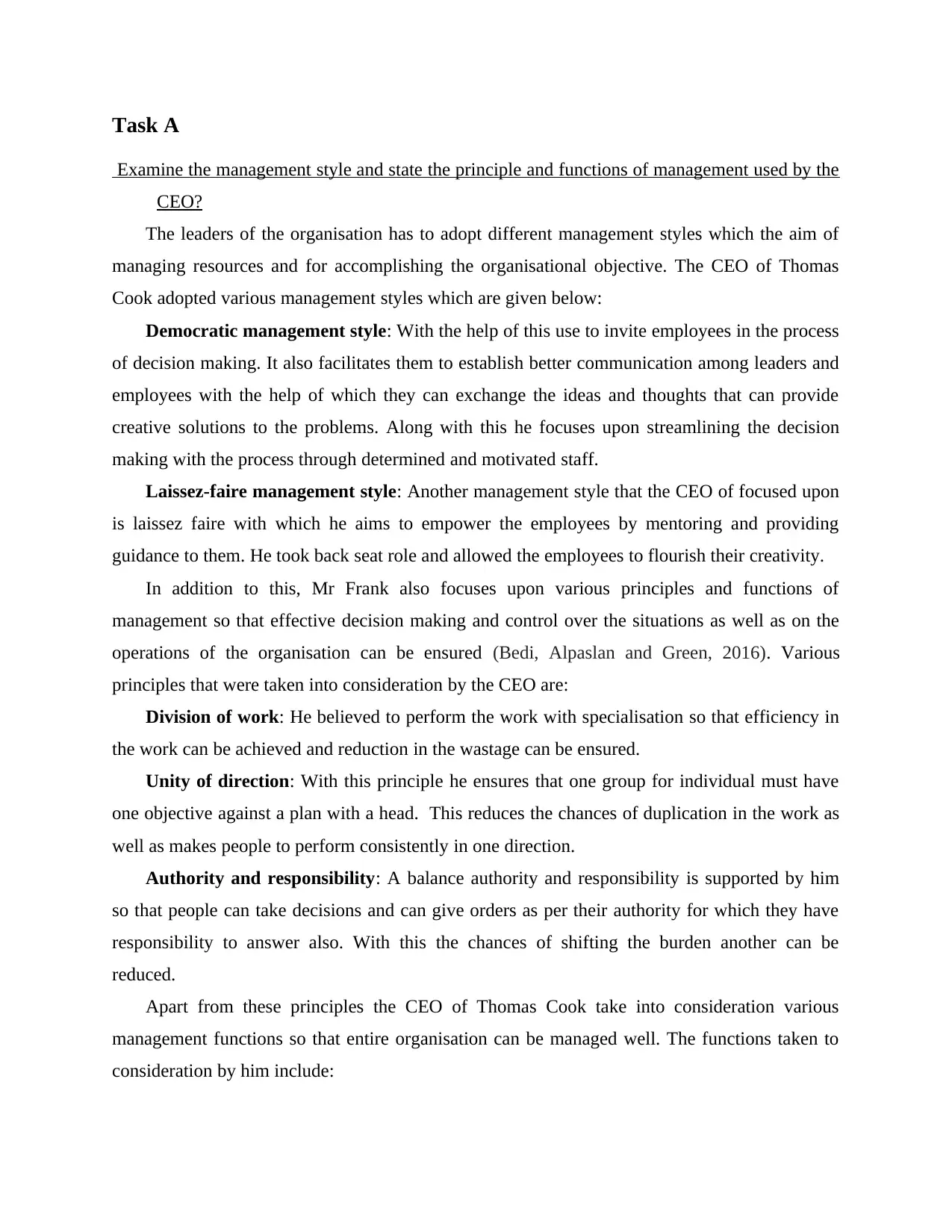
Task A
Examine the management style and state the principle and functions of management used by the
CEO?
The leaders of the organisation has to adopt different management styles which the aim of
managing resources and for accomplishing the organisational objective. The CEO of Thomas
Cook adopted various management styles which are given below:
Democratic management style: With the help of this use to invite employees in the process
of decision making. It also facilitates them to establish better communication among leaders and
employees with the help of which they can exchange the ideas and thoughts that can provide
creative solutions to the problems. Along with this he focuses upon streamlining the decision
making with the process through determined and motivated staff.
Laissez-faire management style: Another management style that the CEO of focused upon
is laissez faire with which he aims to empower the employees by mentoring and providing
guidance to them. He took back seat role and allowed the employees to flourish their creativity.
In addition to this, Mr Frank also focuses upon various principles and functions of
management so that effective decision making and control over the situations as well as on the
operations of the organisation can be ensured (Bedi, Alpaslan and Green, 2016). Various
principles that were taken into consideration by the CEO are:
Division of work: He believed to perform the work with specialisation so that efficiency in
the work can be achieved and reduction in the wastage can be ensured.
Unity of direction: With this principle he ensures that one group for individual must have
one objective against a plan with a head. This reduces the chances of duplication in the work as
well as makes people to perform consistently in one direction.
Authority and responsibility: A balance authority and responsibility is supported by him
so that people can take decisions and can give orders as per their authority for which they have
responsibility to answer also. With this the chances of shifting the burden another can be
reduced.
Apart from these principles the CEO of Thomas Cook take into consideration various
management functions so that entire organisation can be managed well. The functions taken to
consideration by him include:
Examine the management style and state the principle and functions of management used by the
CEO?
The leaders of the organisation has to adopt different management styles which the aim of
managing resources and for accomplishing the organisational objective. The CEO of Thomas
Cook adopted various management styles which are given below:
Democratic management style: With the help of this use to invite employees in the process
of decision making. It also facilitates them to establish better communication among leaders and
employees with the help of which they can exchange the ideas and thoughts that can provide
creative solutions to the problems. Along with this he focuses upon streamlining the decision
making with the process through determined and motivated staff.
Laissez-faire management style: Another management style that the CEO of focused upon
is laissez faire with which he aims to empower the employees by mentoring and providing
guidance to them. He took back seat role and allowed the employees to flourish their creativity.
In addition to this, Mr Frank also focuses upon various principles and functions of
management so that effective decision making and control over the situations as well as on the
operations of the organisation can be ensured (Bedi, Alpaslan and Green, 2016). Various
principles that were taken into consideration by the CEO are:
Division of work: He believed to perform the work with specialisation so that efficiency in
the work can be achieved and reduction in the wastage can be ensured.
Unity of direction: With this principle he ensures that one group for individual must have
one objective against a plan with a head. This reduces the chances of duplication in the work as
well as makes people to perform consistently in one direction.
Authority and responsibility: A balance authority and responsibility is supported by him
so that people can take decisions and can give orders as per their authority for which they have
responsibility to answer also. With this the chances of shifting the burden another can be
reduced.
Apart from these principles the CEO of Thomas Cook take into consideration various
management functions so that entire organisation can be managed well. The functions taken to
consideration by him include:
Paraphrase This Document
Need a fresh take? Get an instant paraphrase of this document with our AI Paraphraser
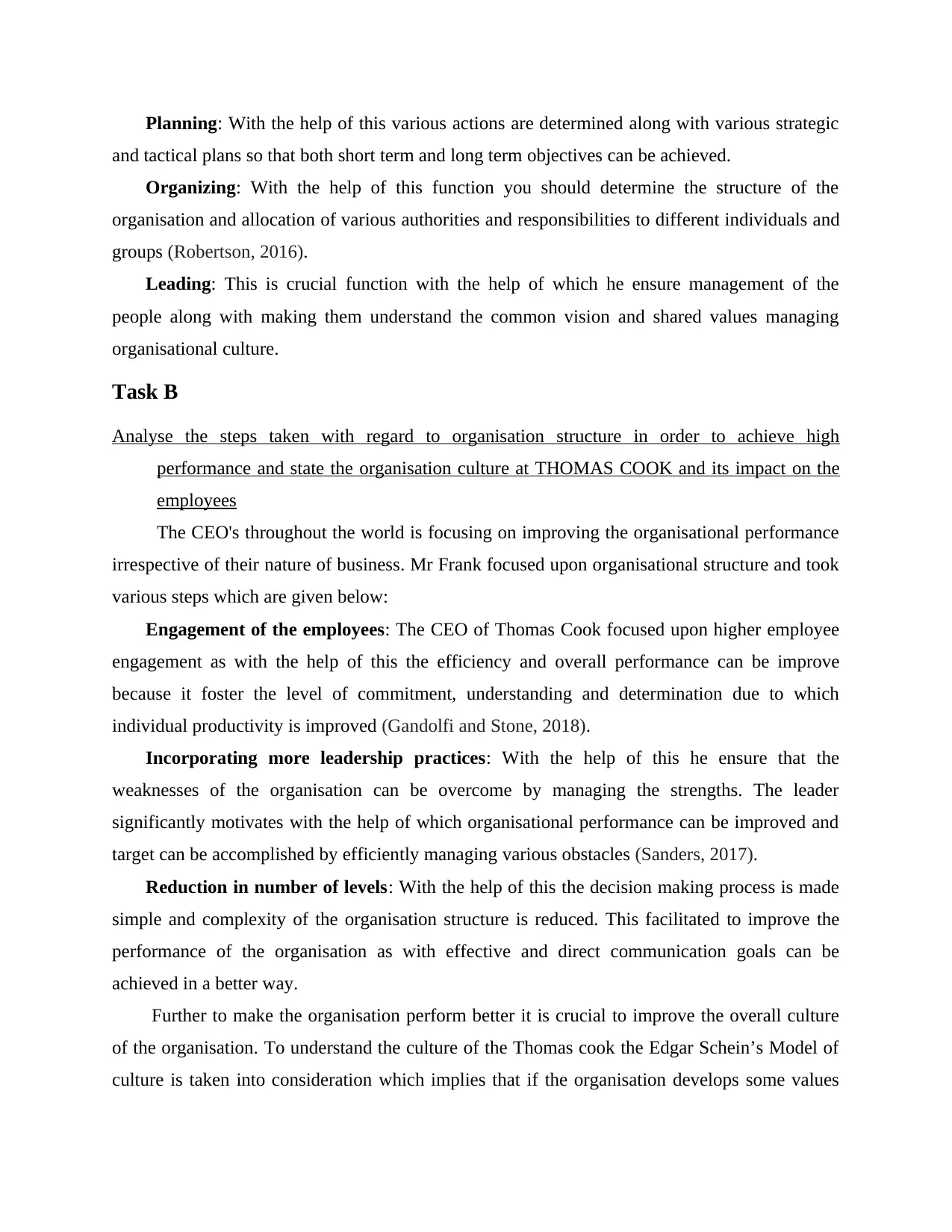
Planning: With the help of this various actions are determined along with various strategic
and tactical plans so that both short term and long term objectives can be achieved.
Organizing: With the help of this function you should determine the structure of the
organisation and allocation of various authorities and responsibilities to different individuals and
groups (Robertson, 2016).
Leading: This is crucial function with the help of which he ensure management of the
people along with making them understand the common vision and shared values managing
organisational culture.
Task B
Analyse the steps taken with regard to organisation structure in order to achieve high
performance and state the organisation culture at THOMAS COOK and its impact on the
employees
The CEO's throughout the world is focusing on improving the organisational performance
irrespective of their nature of business. Mr Frank focused upon organisational structure and took
various steps which are given below:
Engagement of the employees: The CEO of Thomas Cook focused upon higher employee
engagement as with the help of this the efficiency and overall performance can be improve
because it foster the level of commitment, understanding and determination due to which
individual productivity is improved (Gandolfi and Stone, 2018).
Incorporating more leadership practices: With the help of this he ensure that the
weaknesses of the organisation can be overcome by managing the strengths. The leader
significantly motivates with the help of which organisational performance can be improved and
target can be accomplished by efficiently managing various obstacles (Sanders, 2017).
Reduction in number of levels: With the help of this the decision making process is made
simple and complexity of the organisation structure is reduced. This facilitated to improve the
performance of the organisation as with effective and direct communication goals can be
achieved in a better way.
Further to make the organisation perform better it is crucial to improve the overall culture
of the organisation. To understand the culture of the Thomas cook the Edgar Schein’s Model of
culture is taken into consideration which implies that if the organisation develops some values
and tactical plans so that both short term and long term objectives can be achieved.
Organizing: With the help of this function you should determine the structure of the
organisation and allocation of various authorities and responsibilities to different individuals and
groups (Robertson, 2016).
Leading: This is crucial function with the help of which he ensure management of the
people along with making them understand the common vision and shared values managing
organisational culture.
Task B
Analyse the steps taken with regard to organisation structure in order to achieve high
performance and state the organisation culture at THOMAS COOK and its impact on the
employees
The CEO's throughout the world is focusing on improving the organisational performance
irrespective of their nature of business. Mr Frank focused upon organisational structure and took
various steps which are given below:
Engagement of the employees: The CEO of Thomas Cook focused upon higher employee
engagement as with the help of this the efficiency and overall performance can be improve
because it foster the level of commitment, understanding and determination due to which
individual productivity is improved (Gandolfi and Stone, 2018).
Incorporating more leadership practices: With the help of this he ensure that the
weaknesses of the organisation can be overcome by managing the strengths. The leader
significantly motivates with the help of which organisational performance can be improved and
target can be accomplished by efficiently managing various obstacles (Sanders, 2017).
Reduction in number of levels: With the help of this the decision making process is made
simple and complexity of the organisation structure is reduced. This facilitated to improve the
performance of the organisation as with effective and direct communication goals can be
achieved in a better way.
Further to make the organisation perform better it is crucial to improve the overall culture
of the organisation. To understand the culture of the Thomas cook the Edgar Schein’s Model of
culture is taken into consideration which implies that if the organisation develops some values
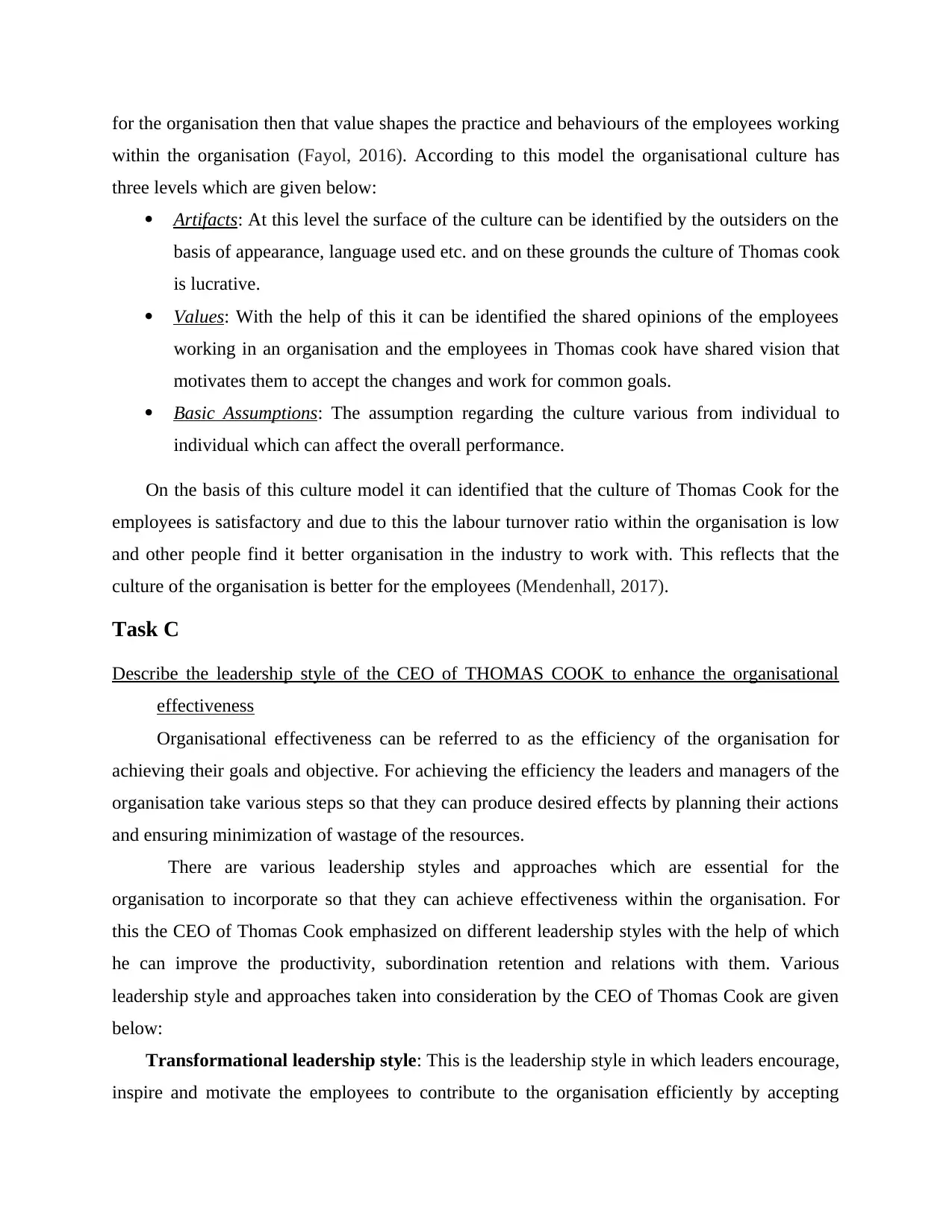
for the organisation then that value shapes the practice and behaviours of the employees working
within the organisation (Fayol, 2016). According to this model the organisational culture has
three levels which are given below:
Artifacts: At this level the surface of the culture can be identified by the outsiders on the
basis of appearance, language used etc. and on these grounds the culture of Thomas cook
is lucrative.
Values: With the help of this it can be identified the shared opinions of the employees
working in an organisation and the employees in Thomas cook have shared vision that
motivates them to accept the changes and work for common goals.
Basic Assumptions: The assumption regarding the culture various from individual to
individual which can affect the overall performance.
On the basis of this culture model it can identified that the culture of Thomas Cook for the
employees is satisfactory and due to this the labour turnover ratio within the organisation is low
and other people find it better organisation in the industry to work with. This reflects that the
culture of the organisation is better for the employees (Mendenhall, 2017).
Task C
Describe the leadership style of the CEO of THOMAS COOK to enhance the organisational
effectiveness
Organisational effectiveness can be referred to as the efficiency of the organisation for
achieving their goals and objective. For achieving the efficiency the leaders and managers of the
organisation take various steps so that they can produce desired effects by planning their actions
and ensuring minimization of wastage of the resources.
There are various leadership styles and approaches which are essential for the
organisation to incorporate so that they can achieve effectiveness within the organisation. For
this the CEO of Thomas Cook emphasized on different leadership styles with the help of which
he can improve the productivity, subordination retention and relations with them. Various
leadership style and approaches taken into consideration by the CEO of Thomas Cook are given
below:
Transformational leadership style: This is the leadership style in which leaders encourage,
inspire and motivate the employees to contribute to the organisation efficiently by accepting
within the organisation (Fayol, 2016). According to this model the organisational culture has
three levels which are given below:
Artifacts: At this level the surface of the culture can be identified by the outsiders on the
basis of appearance, language used etc. and on these grounds the culture of Thomas cook
is lucrative.
Values: With the help of this it can be identified the shared opinions of the employees
working in an organisation and the employees in Thomas cook have shared vision that
motivates them to accept the changes and work for common goals.
Basic Assumptions: The assumption regarding the culture various from individual to
individual which can affect the overall performance.
On the basis of this culture model it can identified that the culture of Thomas Cook for the
employees is satisfactory and due to this the labour turnover ratio within the organisation is low
and other people find it better organisation in the industry to work with. This reflects that the
culture of the organisation is better for the employees (Mendenhall, 2017).
Task C
Describe the leadership style of the CEO of THOMAS COOK to enhance the organisational
effectiveness
Organisational effectiveness can be referred to as the efficiency of the organisation for
achieving their goals and objective. For achieving the efficiency the leaders and managers of the
organisation take various steps so that they can produce desired effects by planning their actions
and ensuring minimization of wastage of the resources.
There are various leadership styles and approaches which are essential for the
organisation to incorporate so that they can achieve effectiveness within the organisation. For
this the CEO of Thomas Cook emphasized on different leadership styles with the help of which
he can improve the productivity, subordination retention and relations with them. Various
leadership style and approaches taken into consideration by the CEO of Thomas Cook are given
below:
Transformational leadership style: This is the leadership style in which leaders encourage,
inspire and motivate the employees to contribute to the organisation efficiently by accepting
⊘ This is a preview!⊘
Do you want full access?
Subscribe today to unlock all pages.

Trusted by 1+ million students worldwide
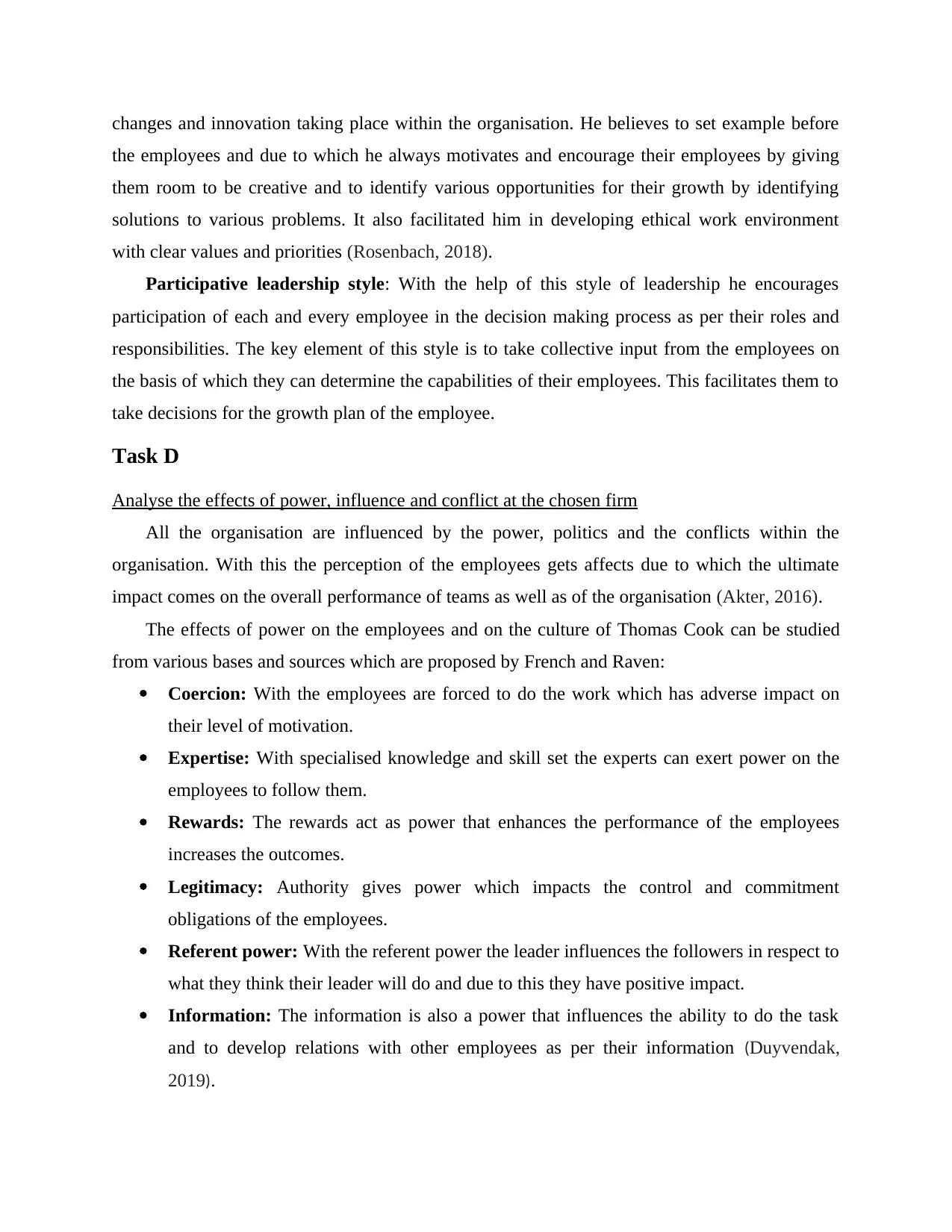
changes and innovation taking place within the organisation. He believes to set example before
the employees and due to which he always motivates and encourage their employees by giving
them room to be creative and to identify various opportunities for their growth by identifying
solutions to various problems. It also facilitated him in developing ethical work environment
with clear values and priorities (Rosenbach, 2018).
Participative leadership style: With the help of this style of leadership he encourages
participation of each and every employee in the decision making process as per their roles and
responsibilities. The key element of this style is to take collective input from the employees on
the basis of which they can determine the capabilities of their employees. This facilitates them to
take decisions for the growth plan of the employee.
Task D
Analyse the effects of power, influence and conflict at the chosen firm
All the organisation are influenced by the power, politics and the conflicts within the
organisation. With this the perception of the employees gets affects due to which the ultimate
impact comes on the overall performance of teams as well as of the organisation (Akter, 2016).
The effects of power on the employees and on the culture of Thomas Cook can be studied
from various bases and sources which are proposed by French and Raven:
Coercion: With the employees are forced to do the work which has adverse impact on
their level of motivation.
Expertise: With specialised knowledge and skill set the experts can exert power on the
employees to follow them.
Rewards: The rewards act as power that enhances the performance of the employees
increases the outcomes.
Legitimacy: Authority gives power which impacts the control and commitment
obligations of the employees.
Referent power: With the referent power the leader influences the followers in respect to
what they think their leader will do and due to this they have positive impact.
Information: The information is also a power that influences the ability to do the task
and to develop relations with other employees as per their information (Duyvendak,
2019).
the employees and due to which he always motivates and encourage their employees by giving
them room to be creative and to identify various opportunities for their growth by identifying
solutions to various problems. It also facilitated him in developing ethical work environment
with clear values and priorities (Rosenbach, 2018).
Participative leadership style: With the help of this style of leadership he encourages
participation of each and every employee in the decision making process as per their roles and
responsibilities. The key element of this style is to take collective input from the employees on
the basis of which they can determine the capabilities of their employees. This facilitates them to
take decisions for the growth plan of the employee.
Task D
Analyse the effects of power, influence and conflict at the chosen firm
All the organisation are influenced by the power, politics and the conflicts within the
organisation. With this the perception of the employees gets affects due to which the ultimate
impact comes on the overall performance of teams as well as of the organisation (Akter, 2016).
The effects of power on the employees and on the culture of Thomas Cook can be studied
from various bases and sources which are proposed by French and Raven:
Coercion: With the employees are forced to do the work which has adverse impact on
their level of motivation.
Expertise: With specialised knowledge and skill set the experts can exert power on the
employees to follow them.
Rewards: The rewards act as power that enhances the performance of the employees
increases the outcomes.
Legitimacy: Authority gives power which impacts the control and commitment
obligations of the employees.
Referent power: With the referent power the leader influences the followers in respect to
what they think their leader will do and due to this they have positive impact.
Information: The information is also a power that influences the ability to do the task
and to develop relations with other employees as per their information (Duyvendak,
2019).
Paraphrase This Document
Need a fresh take? Get an instant paraphrase of this document with our AI Paraphraser
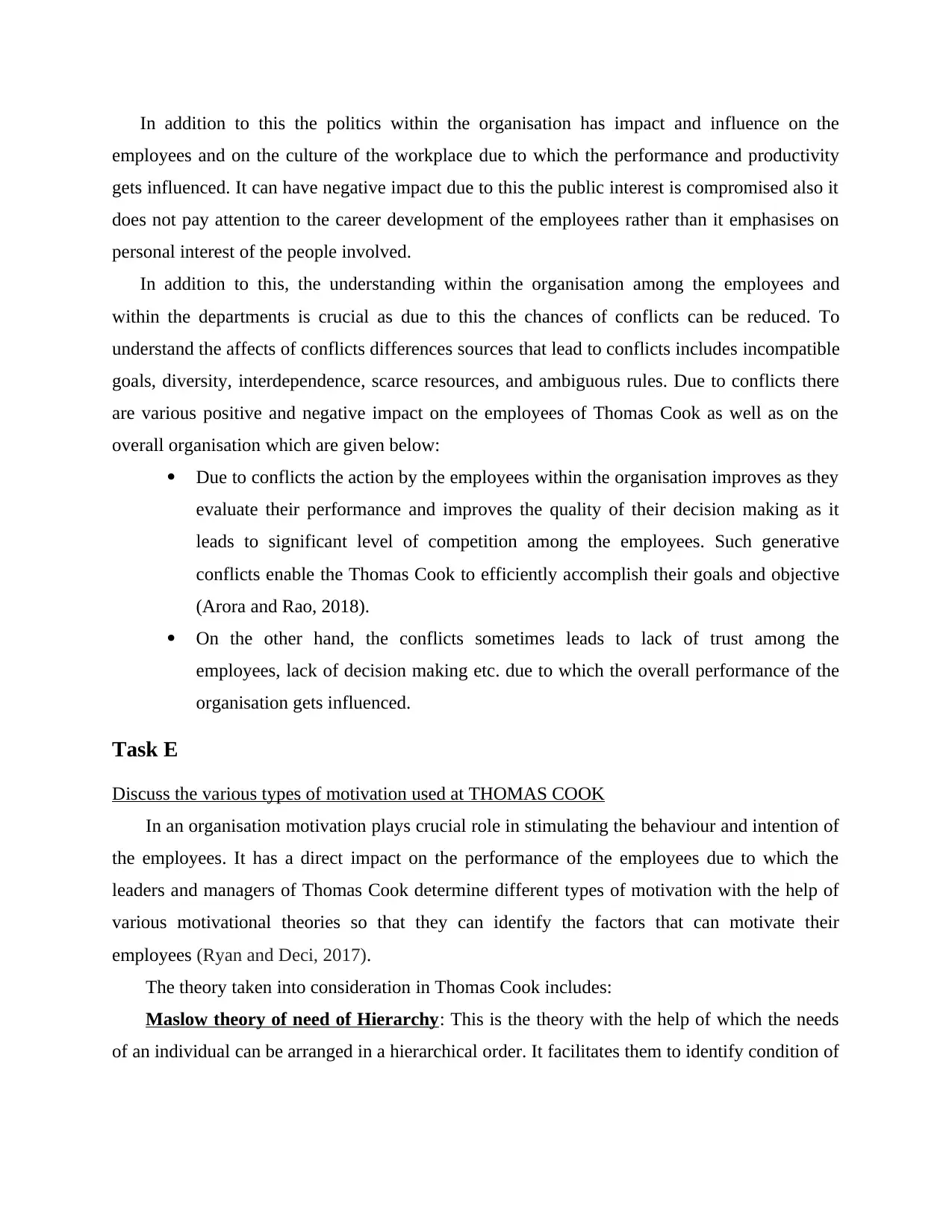
In addition to this the politics within the organisation has impact and influence on the
employees and on the culture of the workplace due to which the performance and productivity
gets influenced. It can have negative impact due to this the public interest is compromised also it
does not pay attention to the career development of the employees rather than it emphasises on
personal interest of the people involved.
In addition to this, the understanding within the organisation among the employees and
within the departments is crucial as due to this the chances of conflicts can be reduced. To
understand the affects of conflicts differences sources that lead to conflicts includes incompatible
goals, diversity, interdependence, scarce resources, and ambiguous rules. Due to conflicts there
are various positive and negative impact on the employees of Thomas Cook as well as on the
overall organisation which are given below:
Due to conflicts the action by the employees within the organisation improves as they
evaluate their performance and improves the quality of their decision making as it
leads to significant level of competition among the employees. Such generative
conflicts enable the Thomas Cook to efficiently accomplish their goals and objective
(Arora and Rao, 2018).
On the other hand, the conflicts sometimes leads to lack of trust among the
employees, lack of decision making etc. due to which the overall performance of the
organisation gets influenced.
Task E
Discuss the various types of motivation used at THOMAS COOK
In an organisation motivation plays crucial role in stimulating the behaviour and intention of
the employees. It has a direct impact on the performance of the employees due to which the
leaders and managers of Thomas Cook determine different types of motivation with the help of
various motivational theories so that they can identify the factors that can motivate their
employees (Ryan and Deci, 2017).
The theory taken into consideration in Thomas Cook includes:
Maslow theory of need of Hierarchy: This is the theory with the help of which the needs
of an individual can be arranged in a hierarchical order. It facilitates them to identify condition of
employees and on the culture of the workplace due to which the performance and productivity
gets influenced. It can have negative impact due to this the public interest is compromised also it
does not pay attention to the career development of the employees rather than it emphasises on
personal interest of the people involved.
In addition to this, the understanding within the organisation among the employees and
within the departments is crucial as due to this the chances of conflicts can be reduced. To
understand the affects of conflicts differences sources that lead to conflicts includes incompatible
goals, diversity, interdependence, scarce resources, and ambiguous rules. Due to conflicts there
are various positive and negative impact on the employees of Thomas Cook as well as on the
overall organisation which are given below:
Due to conflicts the action by the employees within the organisation improves as they
evaluate their performance and improves the quality of their decision making as it
leads to significant level of competition among the employees. Such generative
conflicts enable the Thomas Cook to efficiently accomplish their goals and objective
(Arora and Rao, 2018).
On the other hand, the conflicts sometimes leads to lack of trust among the
employees, lack of decision making etc. due to which the overall performance of the
organisation gets influenced.
Task E
Discuss the various types of motivation used at THOMAS COOK
In an organisation motivation plays crucial role in stimulating the behaviour and intention of
the employees. It has a direct impact on the performance of the employees due to which the
leaders and managers of Thomas Cook determine different types of motivation with the help of
various motivational theories so that they can identify the factors that can motivate their
employees (Ryan and Deci, 2017).
The theory taken into consideration in Thomas Cook includes:
Maslow theory of need of Hierarchy: This is the theory with the help of which the needs
of an individual can be arranged in a hierarchical order. It facilitates them to identify condition of
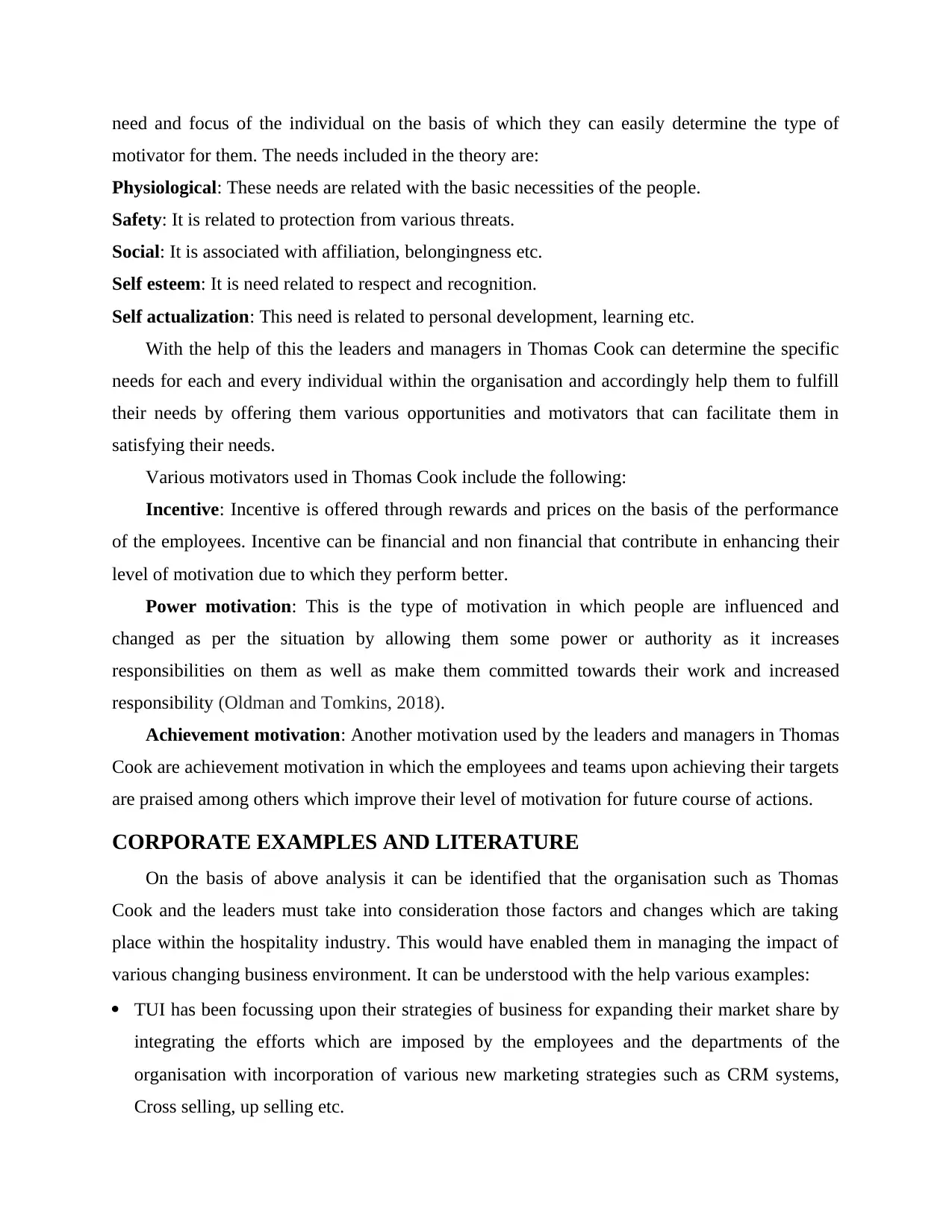
need and focus of the individual on the basis of which they can easily determine the type of
motivator for them. The needs included in the theory are:
Physiological: These needs are related with the basic necessities of the people.
Safety: It is related to protection from various threats.
Social: It is associated with affiliation, belongingness etc.
Self esteem: It is need related to respect and recognition.
Self actualization: This need is related to personal development, learning etc.
With the help of this the leaders and managers in Thomas Cook can determine the specific
needs for each and every individual within the organisation and accordingly help them to fulfill
their needs by offering them various opportunities and motivators that can facilitate them in
satisfying their needs.
Various motivators used in Thomas Cook include the following:
Incentive: Incentive is offered through rewards and prices on the basis of the performance
of the employees. Incentive can be financial and non financial that contribute in enhancing their
level of motivation due to which they perform better.
Power motivation: This is the type of motivation in which people are influenced and
changed as per the situation by allowing them some power or authority as it increases
responsibilities on them as well as make them committed towards their work and increased
responsibility (Oldman and Tomkins, 2018).
Achievement motivation: Another motivation used by the leaders and managers in Thomas
Cook are achievement motivation in which the employees and teams upon achieving their targets
are praised among others which improve their level of motivation for future course of actions.
CORPORATE EXAMPLES AND LITERATURE
On the basis of above analysis it can be identified that the organisation such as Thomas
Cook and the leaders must take into consideration those factors and changes which are taking
place within the hospitality industry. This would have enabled them in managing the impact of
various changing business environment. It can be understood with the help various examples:
TUI has been focussing upon their strategies of business for expanding their market share by
integrating the efforts which are imposed by the employees and the departments of the
organisation with incorporation of various new marketing strategies such as CRM systems,
Cross selling, up selling etc.
motivator for them. The needs included in the theory are:
Physiological: These needs are related with the basic necessities of the people.
Safety: It is related to protection from various threats.
Social: It is associated with affiliation, belongingness etc.
Self esteem: It is need related to respect and recognition.
Self actualization: This need is related to personal development, learning etc.
With the help of this the leaders and managers in Thomas Cook can determine the specific
needs for each and every individual within the organisation and accordingly help them to fulfill
their needs by offering them various opportunities and motivators that can facilitate them in
satisfying their needs.
Various motivators used in Thomas Cook include the following:
Incentive: Incentive is offered through rewards and prices on the basis of the performance
of the employees. Incentive can be financial and non financial that contribute in enhancing their
level of motivation due to which they perform better.
Power motivation: This is the type of motivation in which people are influenced and
changed as per the situation by allowing them some power or authority as it increases
responsibilities on them as well as make them committed towards their work and increased
responsibility (Oldman and Tomkins, 2018).
Achievement motivation: Another motivation used by the leaders and managers in Thomas
Cook are achievement motivation in which the employees and teams upon achieving their targets
are praised among others which improve their level of motivation for future course of actions.
CORPORATE EXAMPLES AND LITERATURE
On the basis of above analysis it can be identified that the organisation such as Thomas
Cook and the leaders must take into consideration those factors and changes which are taking
place within the hospitality industry. This would have enabled them in managing the impact of
various changing business environment. It can be understood with the help various examples:
TUI has been focussing upon their strategies of business for expanding their market share by
integrating the efforts which are imposed by the employees and the departments of the
organisation with incorporation of various new marketing strategies such as CRM systems,
Cross selling, up selling etc.
⊘ This is a preview!⊘
Do you want full access?
Subscribe today to unlock all pages.

Trusted by 1+ million students worldwide
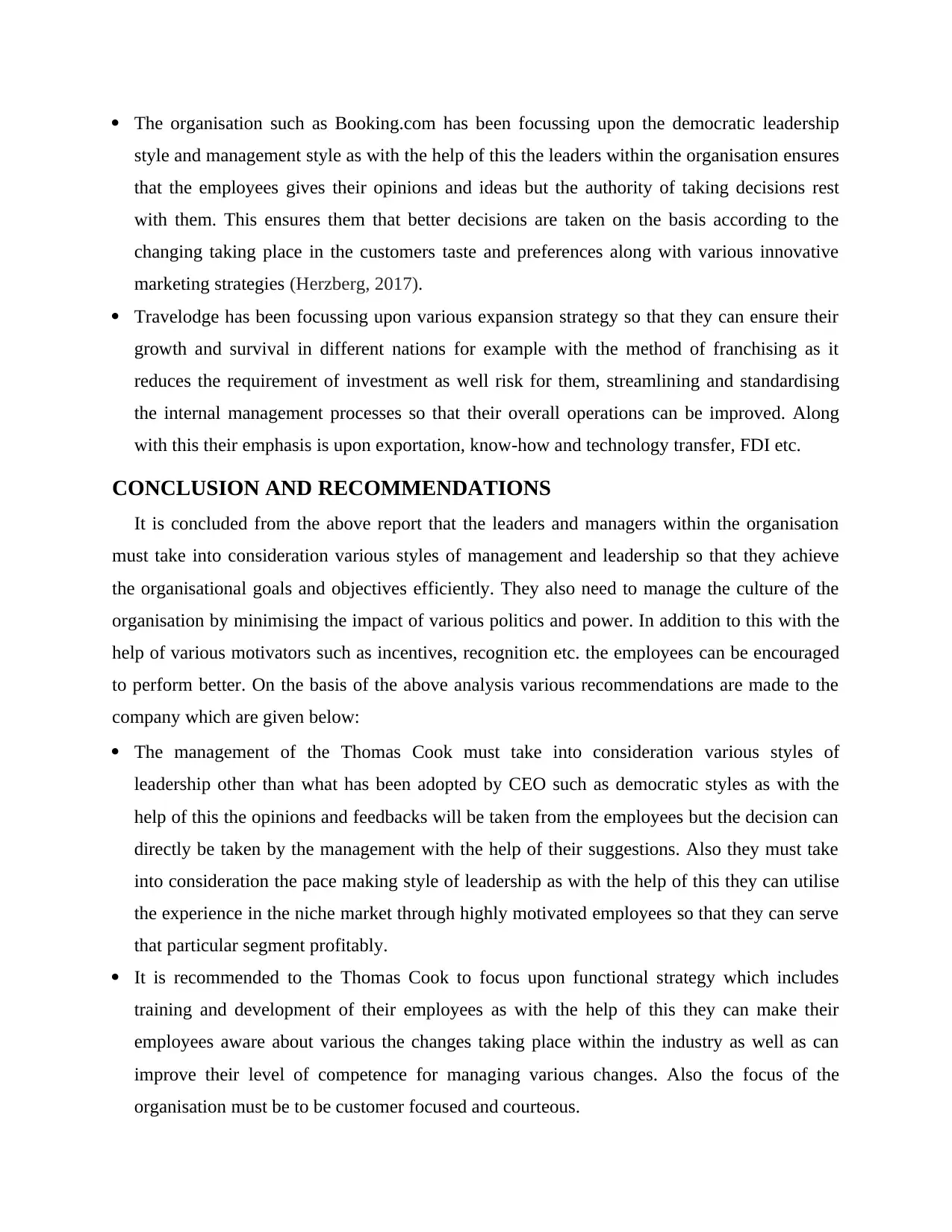
The organisation such as Booking.com has been focussing upon the democratic leadership
style and management style as with the help of this the leaders within the organisation ensures
that the employees gives their opinions and ideas but the authority of taking decisions rest
with them. This ensures them that better decisions are taken on the basis according to the
changing taking place in the customers taste and preferences along with various innovative
marketing strategies (Herzberg, 2017).
Travelodge has been focussing upon various expansion strategy so that they can ensure their
growth and survival in different nations for example with the method of franchising as it
reduces the requirement of investment as well risk for them, streamlining and standardising
the internal management processes so that their overall operations can be improved. Along
with this their emphasis is upon exportation, know-how and technology transfer, FDI etc.
CONCLUSION AND RECOMMENDATIONS
It is concluded from the above report that the leaders and managers within the organisation
must take into consideration various styles of management and leadership so that they achieve
the organisational goals and objectives efficiently. They also need to manage the culture of the
organisation by minimising the impact of various politics and power. In addition to this with the
help of various motivators such as incentives, recognition etc. the employees can be encouraged
to perform better. On the basis of the above analysis various recommendations are made to the
company which are given below:
The management of the Thomas Cook must take into consideration various styles of
leadership other than what has been adopted by CEO such as democratic styles as with the
help of this the opinions and feedbacks will be taken from the employees but the decision can
directly be taken by the management with the help of their suggestions. Also they must take
into consideration the pace making style of leadership as with the help of this they can utilise
the experience in the niche market through highly motivated employees so that they can serve
that particular segment profitably.
It is recommended to the Thomas Cook to focus upon functional strategy which includes
training and development of their employees as with the help of this they can make their
employees aware about various the changes taking place within the industry as well as can
improve their level of competence for managing various changes. Also the focus of the
organisation must be to be customer focused and courteous.
style and management style as with the help of this the leaders within the organisation ensures
that the employees gives their opinions and ideas but the authority of taking decisions rest
with them. This ensures them that better decisions are taken on the basis according to the
changing taking place in the customers taste and preferences along with various innovative
marketing strategies (Herzberg, 2017).
Travelodge has been focussing upon various expansion strategy so that they can ensure their
growth and survival in different nations for example with the method of franchising as it
reduces the requirement of investment as well risk for them, streamlining and standardising
the internal management processes so that their overall operations can be improved. Along
with this their emphasis is upon exportation, know-how and technology transfer, FDI etc.
CONCLUSION AND RECOMMENDATIONS
It is concluded from the above report that the leaders and managers within the organisation
must take into consideration various styles of management and leadership so that they achieve
the organisational goals and objectives efficiently. They also need to manage the culture of the
organisation by minimising the impact of various politics and power. In addition to this with the
help of various motivators such as incentives, recognition etc. the employees can be encouraged
to perform better. On the basis of the above analysis various recommendations are made to the
company which are given below:
The management of the Thomas Cook must take into consideration various styles of
leadership other than what has been adopted by CEO such as democratic styles as with the
help of this the opinions and feedbacks will be taken from the employees but the decision can
directly be taken by the management with the help of their suggestions. Also they must take
into consideration the pace making style of leadership as with the help of this they can utilise
the experience in the niche market through highly motivated employees so that they can serve
that particular segment profitably.
It is recommended to the Thomas Cook to focus upon functional strategy which includes
training and development of their employees as with the help of this they can make their
employees aware about various the changes taking place within the industry as well as can
improve their level of competence for managing various changes. Also the focus of the
organisation must be to be customer focused and courteous.
Paraphrase This Document
Need a fresh take? Get an instant paraphrase of this document with our AI Paraphraser
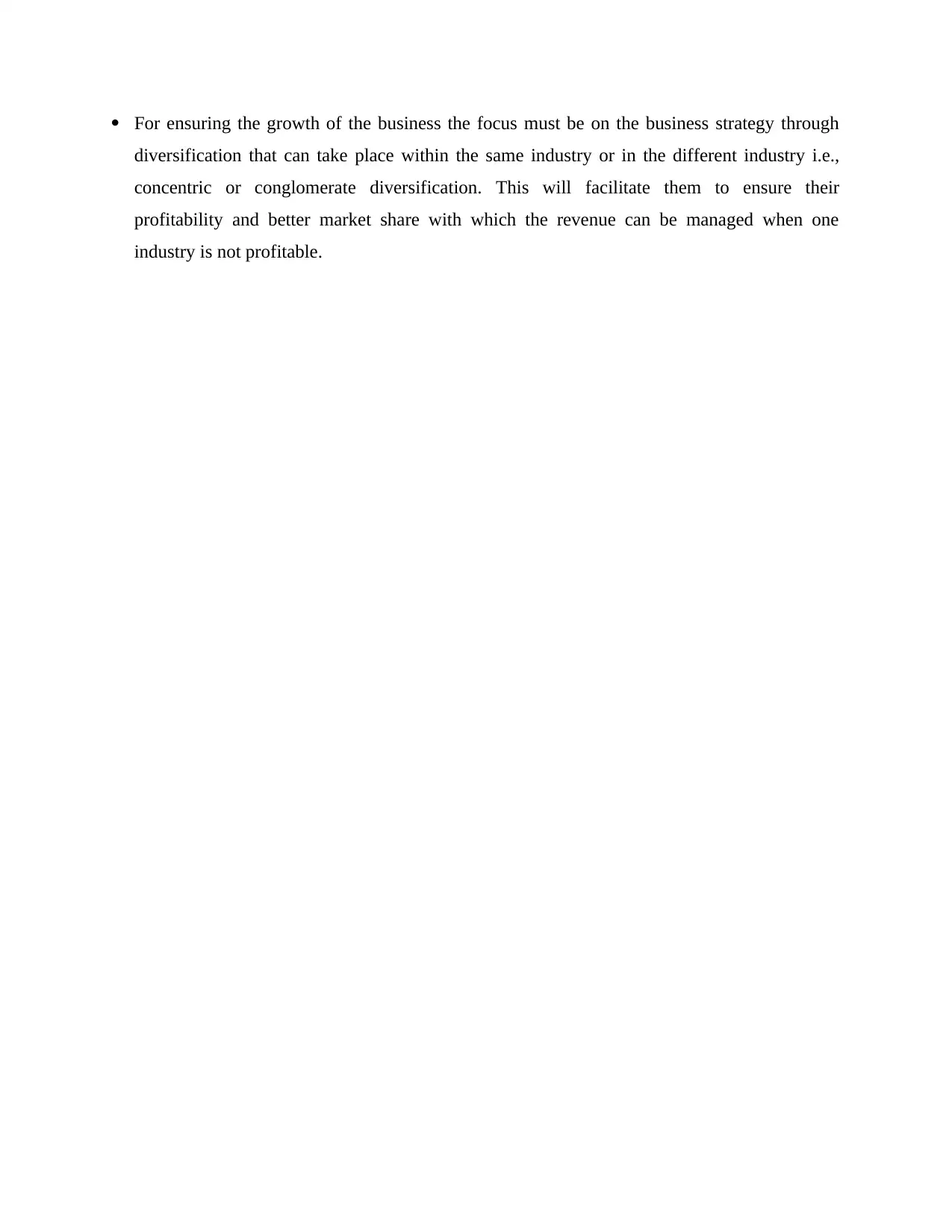
For ensuring the growth of the business the focus must be on the business strategy through
diversification that can take place within the same industry or in the different industry i.e.,
concentric or conglomerate diversification. This will facilitate them to ensure their
profitability and better market share with which the revenue can be managed when one
industry is not profitable.
diversification that can take place within the same industry or in the different industry i.e.,
concentric or conglomerate diversification. This will facilitate them to ensure their
profitability and better market share with which the revenue can be managed when one
industry is not profitable.
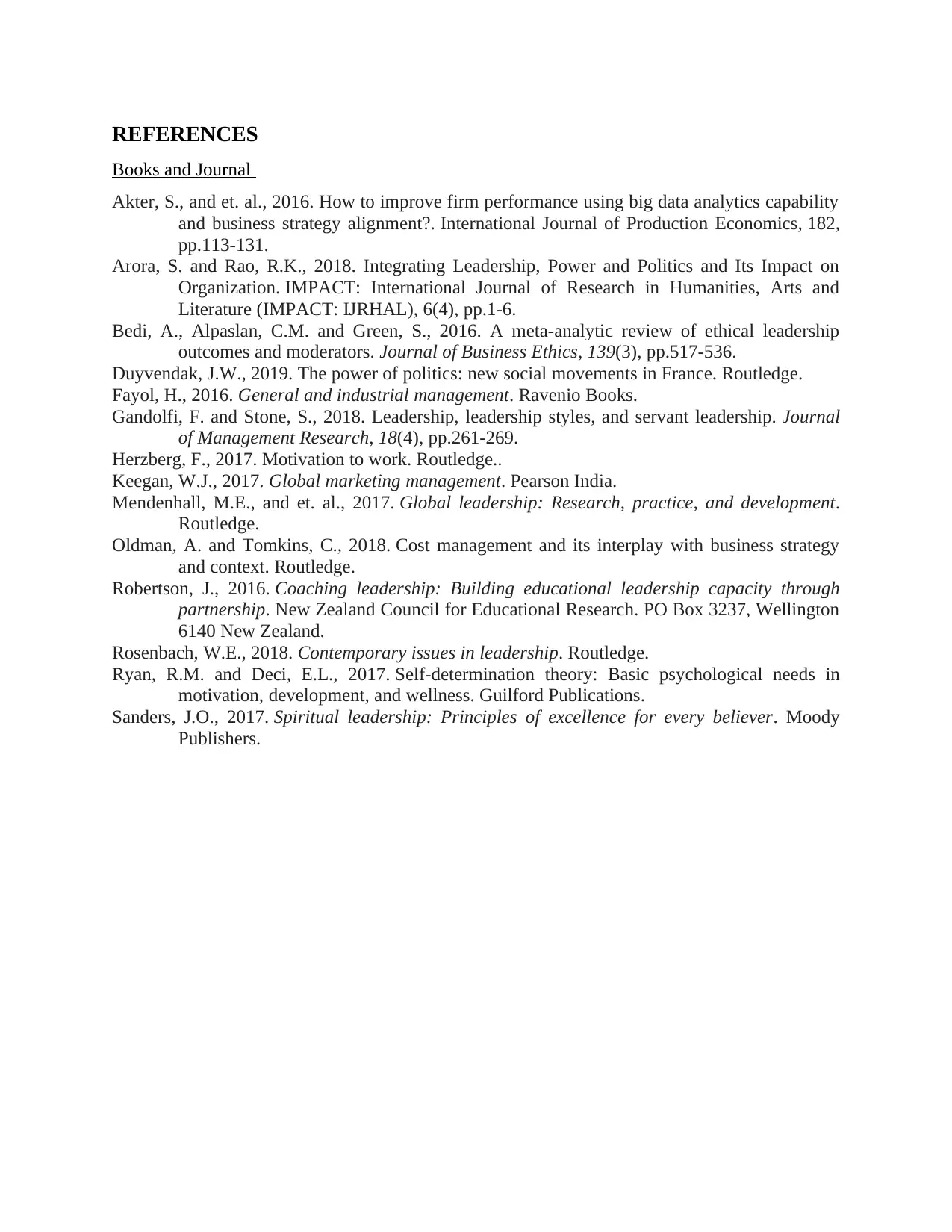
REFERENCES
Books and Journal
Akter, S., and et. al., 2016. How to improve firm performance using big data analytics capability
and business strategy alignment?. International Journal of Production Economics, 182,
pp.113-131.
Arora, S. and Rao, R.K., 2018. Integrating Leadership, Power and Politics and Its Impact on
Organization. IMPACT: International Journal of Research in Humanities, Arts and
Literature (IMPACT: IJRHAL), 6(4), pp.1-6.
Bedi, A., Alpaslan, C.M. and Green, S., 2016. A meta-analytic review of ethical leadership
outcomes and moderators. Journal of Business Ethics, 139(3), pp.517-536.
Duyvendak, J.W., 2019. The power of politics: new social movements in France. Routledge.
Fayol, H., 2016. General and industrial management. Ravenio Books.
Gandolfi, F. and Stone, S., 2018. Leadership, leadership styles, and servant leadership. Journal
of Management Research, 18(4), pp.261-269.
Herzberg, F., 2017. Motivation to work. Routledge..
Keegan, W.J., 2017. Global marketing management. Pearson India.
Mendenhall, M.E., and et. al., 2017. Global leadership: Research, practice, and development.
Routledge.
Oldman, A. and Tomkins, C., 2018. Cost management and its interplay with business strategy
and context. Routledge.
Robertson, J., 2016. Coaching leadership: Building educational leadership capacity through
partnership. New Zealand Council for Educational Research. PO Box 3237, Wellington
6140 New Zealand.
Rosenbach, W.E., 2018. Contemporary issues in leadership. Routledge.
Ryan, R.M. and Deci, E.L., 2017. Self-determination theory: Basic psychological needs in
motivation, development, and wellness. Guilford Publications.
Sanders, J.O., 2017. Spiritual leadership: Principles of excellence for every believer. Moody
Publishers.
Books and Journal
Akter, S., and et. al., 2016. How to improve firm performance using big data analytics capability
and business strategy alignment?. International Journal of Production Economics, 182,
pp.113-131.
Arora, S. and Rao, R.K., 2018. Integrating Leadership, Power and Politics and Its Impact on
Organization. IMPACT: International Journal of Research in Humanities, Arts and
Literature (IMPACT: IJRHAL), 6(4), pp.1-6.
Bedi, A., Alpaslan, C.M. and Green, S., 2016. A meta-analytic review of ethical leadership
outcomes and moderators. Journal of Business Ethics, 139(3), pp.517-536.
Duyvendak, J.W., 2019. The power of politics: new social movements in France. Routledge.
Fayol, H., 2016. General and industrial management. Ravenio Books.
Gandolfi, F. and Stone, S., 2018. Leadership, leadership styles, and servant leadership. Journal
of Management Research, 18(4), pp.261-269.
Herzberg, F., 2017. Motivation to work. Routledge..
Keegan, W.J., 2017. Global marketing management. Pearson India.
Mendenhall, M.E., and et. al., 2017. Global leadership: Research, practice, and development.
Routledge.
Oldman, A. and Tomkins, C., 2018. Cost management and its interplay with business strategy
and context. Routledge.
Robertson, J., 2016. Coaching leadership: Building educational leadership capacity through
partnership. New Zealand Council for Educational Research. PO Box 3237, Wellington
6140 New Zealand.
Rosenbach, W.E., 2018. Contemporary issues in leadership. Routledge.
Ryan, R.M. and Deci, E.L., 2017. Self-determination theory: Basic psychological needs in
motivation, development, and wellness. Guilford Publications.
Sanders, J.O., 2017. Spiritual leadership: Principles of excellence for every believer. Moody
Publishers.
⊘ This is a preview!⊘
Do you want full access?
Subscribe today to unlock all pages.

Trusted by 1+ million students worldwide
1 out of 12
Related Documents
Your All-in-One AI-Powered Toolkit for Academic Success.
+13062052269
info@desklib.com
Available 24*7 on WhatsApp / Email
![[object Object]](/_next/static/media/star-bottom.7253800d.svg)
Unlock your academic potential
Copyright © 2020–2025 A2Z Services. All Rights Reserved. Developed and managed by ZUCOL.




